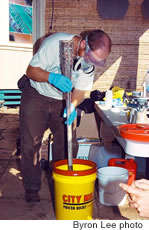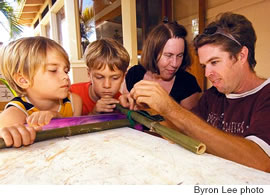Living Green
At The Green House, you can learn to live ‘off the grid’ with solar panels and making biodiesel fuel. You can also have a brownie

Abbott uses an old tiki torch
to mix ingredients to make
biodiesel
Who says environmentalism can’t be fun - or tasty?
“OK, who wants brownies?” bio-chemist Jon Abbott asks his class of elementary schoolers eagerly waiting to taste the chocolate creation baking in a solar oven made of cardboard and tin foil.
When MidWeek first met up with Abbott on Nov. 27, he was where he usually is on a Saturday afternoon - teaching a class at The Green House in Pauoa Valley. On this particular day, Abbott shows children and their parents how to make their own solar cooker with mostly cardboard, tin foil and duct tape. To demonstrate, Abbott bakes eggless brownies in two ovens, which he placed outside in the sun for three and a half hours, prior to the class.
The larger one reaches about 212 degrees F and the smaller one makes it to about 100 degrees.
“It’s not a toy,” he cautions. “It’s like a real oven. You can really burn yourself. The tape’s melted right off,” he continues as he shows the children the melted duct tape, then lets the boys and girls smell the brownies.

Jon Abbott produces cooked brownies from a
homemade solar oven at The Green House in
Pauoa Valley
Elsewhere at The Green House on the same afternoon, 80-year-old Oahu resident Evelyn Giddings teaches a small group the fine art of composting. Also outside, a third class in bamboo craft making has participants creating useful household items.
Besides Abbott and Giddings, the owner of the house, Betty Gearen, teaches these courses and others on everything from growing culinary herbs in pots to soap-making and recycling to paper-making to making your own biodiesel. Through The Green House, Gearen and Abbott teach others how to use the resources around them for everyday needs and, as a result, save money and energy. They encourage people to turn a problem into a solution, like taking something which is normally considered waste and reusing it for something functional.
“We educate people to live sustainably in their own back yards,” Abbott says. “You can grow what you need right where you are.”

Keahi and Kala Diaz and Candace Goodman learn to
make bamboo products from Elko Evans
Abbott knows all about living sustainably. Outside of The Green House, he helps Oahu residents to “live off the grid” and save on their energy bills by installing solar hot water panels on their homes. Solar hot water panels heat water using sunlight, allowing homeowners to create their own electricity. In the ‘30s, Abbott explains, solar panels were widely used on homes on Hawaii, but as our society became more and more dependent on the convenience of other non-renewable technologies, solar power faded into the background. But now, he adds, more Oahu residents are beginning to learn of the tax breaks (not to mention money you can save on your electric bill) associated with solar hot water panels and are having the panels installed.
“The only real wasteland is anywhere there is a roof with no solar panels,” Abbott attests.
Like Abbott, Gearen also encourages living sustainably. Her front yard is beautifully shaded by a large banana tree. Below it on the ground grow basil, sweet potatoes, aloe, avocado, pineapples, ginger and a plethora of other natural foods. She uses the concept of permiculture, how to live with nature, to make the most of her natural surroundings. Potted plants are strategically placed to catch maximum sunlight, and her rock garden is built with many levels to create little climates for each growth. Inside her home some of the floor boards are made from recycled wood from old gymnasiums.
“We’re hungry for that community. We’re hoping to create a community of sustainable lives,” Gearen says. “We show others how easy it is to follow along.”
If you’re not interested in attending a class, but would like to learn the ways of living sustainably on your own, Abbott has a few suggestions. Turn off the lights when you leave a room, don’t let your faucet run and be sure to fix a running toilet or leaky faucet as soon as possible.
He also suggests using recycled cardboard because it “is a great resource. It takes it out of the waste stream.” Not only is it great for solar ovens, it also works as a material to prevent the growth of weeds in your yard. Abbott points to any area of the ground on the side of the house and says that beneath the top layer of wood chips lie pieces of cardboard.
Page 1 of 2 pages for this story 1 2 >
E-mail this story | Print this page | Comments (0) | Archive | RSS
Most Recent Comment(s):








